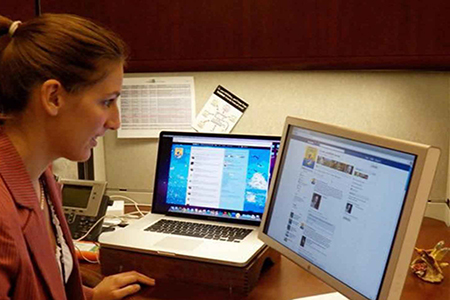No they’re not in the dictionary yet but chances are you didn’t blink at these names. As a high school student you probably have an account on one or more of these websites. And if you don’t it’s possible you’ve seen the most popular videos on YouTube more times than is healthy. If any of this describes you congratulations! You are part of the social media movement. Believe it or not this movement is quickly changing the face of college admissions academics student life and even your future beyond college.
Just what is social media?
Social media is online media that is interactive- that means anybody can create it comment on it change it and update it in real time. For example if you upload photos to Facebook you are adding interactive content to the site; other Facebook users can view comment on and even share them with other people (if you let them). Or if you post to your blog you’re likewise creating Internet content that didn’t exist 20 minutes ago.
The most common social media applications are social networks which are Internet sites that connect people and their information. MySpace and Facebook are the most commonly known social networking sites. But a new social network that’s quickly growing in popularity is Twitter. Even though few high school students use Twitter yet it is already the third-largest social networking site in the world. It allows its users to post ultra-short status updates called “tweets” and communicate with others through the site. You can view your friends’ Twitter feeds on the website itself or have them automatically sent to your cell phone. Many businesses also use Twitter to communicate with their customers about their latest products and activities.
An increasing number of colleges have Twitter accounts to promote events and update potential applicants about new developments at their schools. Colleges like the University of Illinois Viterbo University Oregon State University and Johns Hopkins University have established Twitter pages on which you can follow what’s happening in admissions.
Some colleges have taken Twitter even further. For example Georgia Tech has 25 “feeds” where you can follow what’s happening in a wide range of academic departments sports and general campus news. As stated on the college’s website Twitter users communicate in 140 characters or less to answer one simple question: What are you doing?
Digg is another trendy social network: Its users determine which sites images and videos on the Internet are the most popular. Users submit their own content and others can click on the “Digg” button to determine what they like best (items with the most “Diggs” move to the front page). On Flickr people can post and share personal photos. And don’t forget YouTube one more social site known for its massive database of videos posted by anybody and everybody- ranging from hilarious to rude to mundane to just plain bizarre.
Web 2.0
All of these websites fall under an Internet umbrella called Web 2.0. When the Internet first became accessible to the general public in the 1990s it was mainly a collection of static websites that provided direct information (called Web 1.0). By contrast Web 2.0 is interactive in nature. Its information can be changed by you the Internet user. Although some experts are saying that the Internet is moving toward Web 3.0 there is no official agreement about what that means yet.
So what does all of this geek talk mean for your future? Well it’s going to mean plenty! Once you start researching colleges and universities you will discover a whole world of Web 2.0 and social media opportunities that can help you find choose and gain acceptance to the colleges you want. It’s essential to look both at how colleges are using these social media outlets and how you can use social media to represent yourself in the best possible light as you begin the application process.
How Colleges Use Social Media
Colleges are taking advantage of the social media movement to market themselves to you. As a college shopper in this environment you have the good fortune of being able to collect more information than any student who has come before. Indiana University (IU) is one such school that has started using social media in order to help people learn more about it. Sarah Gallagher Dvorak director of communications at IU says that the university uses student-written blogs as one way to recruit potential applicants.
“High school students have the opportunity to read about the lives of IU scholars which helps to paint a picture of their future selves at IU,” she says. Indiana also has a Facebook page that accepted students can join in order to build a sense of first-year community before they arrive on campus. Dvorak points out the immediate convenience of IU’s online presence: “We currently have more than 2000 fans of the page and within the first 12 hours the page was live we had approximately 800.”
Agnes Scott College in Georgia even encourages high-schoolers to become fans of their Facebook admissions page before applying. Social media gives us an opportunity to have frank discussions about the truths and myths of attending a women’s college and a liberal arts college,” says Kerry Meyers the school’s director of Internet communications. On the page curious students can join admissions discussions or have a conversation with an admissions counselor. It allows students to learn about the special identity and quirks of Agnes Scott from many people on campus,” Meyers adds.
Johns Hopkins (JHU) and SUNY Plattsburgh are two schools that have integrated social media into “every phase of the admissions process,” according to Daniel Creasy JHU associate admissions director. Both universities post video blogs on YouTube in addition to maintaining a presence on blogging sites Facebook and Twitter. SUNY Plattsburgh additionally uses Flickr to allow students to post photos of campus life.
Creasy says that teenagers are especially comfortable with social media noting “We are communicating with today’s youth the way they communicate with each other.” Devin Mason, associate director of new media at SUNY Plattsburgh confirms this: “Facebook is where our students are. They are far more engaged with what goes on there than they are with traditional media or e-mail.”
How You Should Use Social Media
While your comfort level with social media may be extremely high remember that your risk level can also be high. Information-sharing of any kind has some risk attached and when you are putting information about yourself into cyberspace you are consciously (or unconsciously) conveying a certain image to anybody who can access that information.
Maintain a Facebook profile that is formal and professional while still spotlighting your interests and involvement with activities. But take your cyber-persona a step further: Don’t just maintain your image- promote it! Schools are interested in your many facets as a person. If you can use the Internet to show schools a more vivid picture of who you truly are then do it.
For example if you are interested in astronomy try starting a stargazing update feed on Twitter. If you aspire to be a creative writer you can develop a writing portfolio blog that showcases your best work. Become a fan of the Facebook pages of the schools you want to apply to and make your presence known: Join admissions discussions and start new ones. You could even upload a personal video essay on YouTube. Your relationship with social media isn’t passive; it’s active. Take this fabulous opportunity to creatively and respectfully put yourself online before you even start the formal application process.
You can also build a great online community for yourself that will connect you to your campus immediately after you are admitted. Dvorak explains this advantage: “We are able to create an IU community in a way traditional communication methods don’t provide. Becoming part of a community helps [students] embrace and internalize a sense of belonging that may have otherwise been difficult to come by.” As you represent yourself and build community be careful not to put anything online that is embarrassing or too personal. Colleges may see your profile so think about whether your admission or scholarship chances would be enhanced or jeopardized before you post anything.
Social Media in College and in the Workplace
As 21st-century technology advances you will undoubtedly need to know how to use social media skills in almost any future job. Since you will probably use social media in the workplace no matter what you can use the next few years of your life-while the economy is down- to enhance the skills you are already developing as a teenager.
Not only can you use social media skills to help you get into college but you can also use them to your advantage once you’re in college and even beyond. So many companies are looking for new graduates well-versed in Web 2.0 culture that if you start now you can build the essential skills you need over the next four to six years. Companies and organizations use social networking to discover and hire interns and new employees. As a college student you can develop business contacts; gain information about what career you want to pursue; build a community of people online; and communicate with acquaintances professors and working professionals. Networking doesn’t have to start after college. Sometimes the best jobs opportunities and relationships come from knowing the right people-so why not know the right people online as well?
Mason of SUNY emphasizes building these skills inside and outside of the classroom over the next few years of your life. “To be successful you really need to understand how people use the Internet,” he explains. “You really need to have a balanced understanding of not only marketing but also sociology-and to some degree psychology”-which includes being aware of how you use social media yourself.
While you’re in college you may also be able to work with the admissions office to help represent the university to high school students younger than you! This could help you connect to future college students. Mason says, “One of our main goals in higher education is to make sure our audiences feel like they are a part of something so showcasing them in any way helps make this a reality.” Stacy Kostell, director of admissions at the University of Illinois agrees. “It … allows us to let our current students speak about their experiences in an unmonitored way which gives credibility to our messages.”
As a high school student and a future college student you have the Web 2.0 world literally at your fingertips. Maybe you will spearhead the newest social media trend help develop a social media major at your university or use the Internet to make your college application pop. Whenever you sign on to your computer you are already building the skills you need. And the best part is colleges are getting ready to partner with you as you help create the trends courses and jobs of the future.
Jill Schoepf is the online editor of My College Guide.



